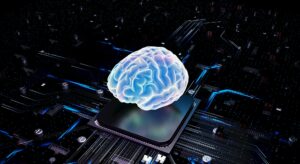How Artificial Intelligence Is Changing Cybersecurity from a Reactive to a Predictive Approach

How Artificial Intelligence Is Changing Cybersecurity from a Reactive to a Predictive Approach
For several decades, cybersecurity was comparable to a fire service in that it responded to incidents after they had already taken place. The defense of networks was traditionally handled by traditional methods, which relied on human analysts, signature-based detection, and known threat patterns. In spite of this, this reactive approach began to fail as cyber threats got more complex, rapidly evolving, and adaptable. These days, Artificial Intelligence (AI) is completely redefining cybersecurity from the ground up. Defense techniques are transitioning from detecting attacks that have already occurred to anticipating and stopping attacks that will occur in the future before they occur.
The Constraints that Traditional Cybersecurity Methods Impose
Conventional cybersecurity technologies concentrate on recognizing harmful code, behaviors, or traffic patterns that are similar to established threat signatures. Despite its effectiveness against well-known attacks, this paradigm has a difficult time dealing with zero-day exploits, insider threats, and malware that is constantly developing. The ability to conceal themselves within legal communications, automate attacks, and exploit weaknesses at a faster rate than human teams can respond has been acquired by hackers. As a consequence of this, security personnel frequently find themselves working behind the times, discovering breaches only after the damage has already been done.
The Emergence of Security Driven by Artificial Intelligence
Artificial intelligence (AI) is able to spot patterns, abnormalities, and possible risks in real time by utilizing machine learning, deep learning, and natural language processing. This paradigm shift is brought about by AI. Artificial intelligence systems learn dynamically from vast volumes of network data, emails, system logs, and user behavior. This is in contrast to the traditional approach of depending entirely on pre-programmed rules. As a result, they are able to foresee risks and automatically intervene, so converting cybersecurity from a reactive defense to a proactive protection.
AI Cyber Defense is Built on the Foundation of Learning from Data
For cybersecurity systems that are powered by artificial intelligence, data is the lifeblood; every network packet, login attempt, or email becomes a piece of the security puzzle. Through the process of continuously analyzing various data streams, artificial intelligence models are able to understand what constitutes “normal” activity for a specific system or organization. Once this baseline has been established, even the smallest change, such as an unexpected data transfer, a login from a different location, or an odd execution of code, can cause an alarm or an automated response to be triggered.
Having the ability to recognize patterns enables artificial intelligence to identify even the most minute irregularities well in advance of their escalation into full-scale attacks. In the course of time, the system will become more intelligent, adjusting to new behaviors and improving its predictions through the process of continuous learning.
Predictive prevention is the next step after reactive detection.
Prediction is the most significant change that artificial intelligence provides to the field of cybersecurity. Artificial intelligence systems are able to foresee potential vulnerabilities and threat vectors, as opposed to just identifying attacks that are already taking place within the system. The use of advanced analytics in predictive cybersecurity allows for the evaluation of risk levels, the modeling of probable attack vectors, and the recommendation of different mitigation solutions before attackers strike.
Artificial intelligence, for example, is able to examine code repositories and system configurations in order to identify vulnerabilities, simulate how a hacker would exploit such vulnerabilities, and recommend preventative actions. Through the observation of early behavioral indications, it is able to forecast the possibility of phishing attempts or ransomware outbreaks occurring in system contexts that involve networks.
Conducting Behavioral Analytics and Identifying Anomalies
The field of behavioral analytics is where artificial intelligence has made one of its most significant contributions. Through an analysis of the ordinary functioning of people, apps, and systems, artificial intelligence is able to recognize aberrant behavior that may be indicative of a breach. The artificial intelligence system has the capability to identify and isolate any behavior that occurs in real time, such as when an employee suddenly begins accessing huge amounts of data outside of work hours or sending files to unknown places.
This method goes beyond the traditional rule-based detection method; it takes into account both the purpose and the context. Specifically, it is able to differentiate between legitimately odd behavior, such as logging in remotely while traveling, and malevolent conduct, such as an attack that involves stuffing credentials.
In the realm of cybersecurity, the function of natural language processing
The use of natural language processing (NLP) by artificial intelligence is also broadening the scope of cybersecurity. Public forums, social media, and the dark web can all be monitored using NLP models in order to identify early references of newly discovered exploits or credentials that have been compromised. Through the examination of human language, these algorithms are able to identify early warning indicators of new malware campaigns or zero-day vulnerabilities. When this occurs, security teams are able to take preventative measures, such as patching systems or updating defenses, before assaults begin to spread broadly.
Incident Response and Automation of Processes
Artificial intelligence not only recognizes potential dangers but also assists in mitigating them. Without the need for human intervention, automated incident response solutions are able to isolate infected devices, terminate malicious activities, and begin forensic investigation without waiting for human input. Because of this automation, response times are dramatically reduced, frequently from hours to seconds, which in turn limits the amount of damage that can be caused by attackers.
Artificial intelligence assists in prioritizing threats based on severity and context in large businesses, which receive hundreds of alerts on a daily basis. By filtering out false positives and concentrating attention on genuine dangers that require expert assessment, it prevents human analysts from being overwhelmed by noise and instead concentrates on the real threats.
Using Generative Models to Make Predictions Regarding Future Dangers
Generative artificial intelligence adds still another level of sophistication. Generic models are able to examine the resilience of a system against new or hypothetical threats by simulating probable attack scenarios based on those scenarios. In addition, they can assist cybersecurity teams in “thinking like hackers,” which means that they can generate potential exploit pathways to uncover vulnerabilities in advance. Through the use of this self-testing capabilities, businesses are able to upgrade their defenses in a proactive manner, well in advance of attackers discovering the same vulnerabilities.
Real-World Applications and Examples of Recent Achievements
Across all sectors, cybersecurity that is powered by AI is already demonstrating its effectiveness. Artificial intelligence is used by financial organizations to identify fraudulent transactions in real time by identifying trends in spending habits that are not typical. The use of predictive algorithms by cloud service providers allows for the simultaneous monitoring of millions of endpoints, which helps to avoid the spread of malware across networks. For the purpose of analyzing enormous streams of intelligence data and spotting prospective cyber operations before they take place, governments and defense organizations rely on artificial intelligence.
In the realm of email filtering, artificial intelligence is a significant example. Nowadays, machine learning systems are able to identify phishing efforts not just by searching for links that appear to be suspicious, but also by analyzing sentence structure, tone, and intent. This allows them to recognize social engineering techniques that are not obvious to traditional filters.
In the field of cybersecurity, the Human–AI Partnership
Despite its potential, artificial intelligence is not a substitute for the expertise of humans. Instead, it enhances the force that is already present. Expertise in judgment, ethical reasoning, and contextual understanding are all things that artificial intelligence (AI) does not yet possess. Artificial intelligence is responsible for managing continuous monitoring and pattern recognition, while humans are responsible for interpreting complicated warnings, investigating deeper dangers, and making strategic judgments. Together, these two components comprise a hybrid defensive model.
Additionally, this relationship helps to alleviate feelings of exhaustion and burnout among cybersecurity experts, who frequently deal with excessive amounts of work. Experts are able to devote their attention to creative problem-solving and higher-level strategy when AI is responsible for performing repetitive chores.
Considerations of Ethical Implications and Obstacles
It is also important to note that the incorporation of AI into cybersecurity presents new concerns. In order to construct convincing phishing messages, avoid detection, and automate large-scale operations, attackers are now actively exploiting artificial intelligence (AI) themselves. Because of this, a “AI vs. AI” dynamic has been sparked, in which both defenders and attackers are continuously evolving their algorithms in an effort to improve their technological capabilities.
It is also risky to rely excessively on artificial intelligence systems. Incomplete or biased training data can result in false positives or missed threats, while opaque “black-box” models might make it difficult to explain why certain judgments were reached. Both of these issues cause false positives and missed threats. Artificial intelligence-driven military systems must adhere to the principles of transparency, justice, and accountability in order to preserve both confidence and efficacy.
The Path Forward: Scalable Predictive Security in the Future
Predictive intelligence, which refers to systems that continuously learn, adapt, and forecast threats on a global scale, is where the landscape of cybersecurity is headed in the future. A further improvement in artificial intelligence’s capacity to evaluate encrypted data without compromising users’ privacy could be achieved through integration with quantum computing and federated learning. The use of fully autonomous security ecosystems that are able to perform self-monitoring, self-healing, and self-adaptation in real time will soon become the norm for commercial enterprises.
From Defense to Priority Planning
Artificial intelligence has turned cybersecurity from a defensive mechanism that is reactive into a discipline that is proactive and predictive. AI enables enterprises to keep ahead of developing digital risks by recognizing patterns, anticipating attacks, and responding autonomously. This allows organizations to stay better prepared. An important turning point has occurred, which is the transition from reaction to foresight. This is the point at which cybersecurity is no longer about cleaning up after breaches, but rather about preventing them entirely. Artificial intelligence is not merely a tool in this new era of intelligent defense; rather, it is the most important factor in ensuring resilience in the digital age.




